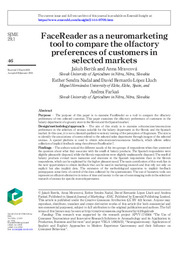Por favor, use este identificador para citar o enlazar este ítem:
https://hdl.handle.net/11000/36516Registro completo de metadatos
| Campo DC | Valor | Lengua/Idioma |
|---|---|---|
| dc.contributor.author | López Lluch, David | - |
| dc.contributor.author | Sendra, Esther | - |
| dc.contributor.author | Bercík, Jakub | - |
| dc.contributor.author | Mravcova, Anna | - |
| dc.contributor.author | Farkaš, Andrea | - |
| dc.contributor.other | Departamentos de la UMH::Economía Agroambiental,Ing. Cartográfica y Expresión Gráfica en la Ingeniería | es_ES |
| dc.date.accessioned | 2025-04-16T08:15:07Z | - |
| dc.date.available | 2025-04-16T08:15:07Z | - |
| dc.date.created | 2024-01 | - |
| dc.identifier.citation | Spanish Journal of Marketing - ESIC Vol. 29 No. 1, 2025 pp. 46-64 | es_ES |
| dc.identifier.issn | 2444-9709 | - |
| dc.identifier.uri | https://hdl.handle.net/11000/36516 | - |
| dc.description.abstract | Purpose – The purpose of this paper is to examine FaceReader as a tool to compare the olfactory preferences of two selected countries. This paper examines the olfactory preferences of customers in the bakery department of a grocery store in the Slovak and the Spanish market. Design/methodology/approach – The aim of this study is to examine subconscious/unconscious preferences in the selection of aromas suitable for the bakery department in the Slovak and the Spanish market. In this case, it is not a classical qualitative sensory testing of the perception of fragrances. The aim is to identify the associations of scents related to the selected sales department through images of the selected aromas. A special platform is used to obtain subconscious/unconscious feedback, which allows online collection of implicit feedback using the software FaceReader 7. Findings – The authors noticed the different moods of the two groups of respondents when they answered the question about what they associate with the smell of bakery products. The Spanish respondents were slightly pleasantly disposed, while the Slovak respondents were slightly unpleasantly disposed. The smell of bakery products evoked more memories and emotions in the Spanish respondents than in the Slovak respondents, which can be explained by the higher pleasant mood. The main contribution of this work lies in the new opportunities to obtain feedback that can be used in marketing research and that rely not only on explicit but also implicit data. The extension of the methodological apparatus to implicit feedback presupposes some form of control of the data collected by the questionnaire. The use of biometric tools can represent an efficient alternative in terms of time and money to the use of neuroimaging tools in the selection/ research of aromas for specific stores/departments. | es_ES |
| dc.description.abstract | Objetivo – El objetivo de esta investigacion es examinar FaceReader como una herramienta para comparar las preferencias olfativas entre dos países. Concretamente, examinamos las preferencias olfativas de los clientes en el departamento de panadería de un supermercado en el mercado eslovaco y español. Diseño/metodología/enfoque – El objetivo de este estudio es examinar las preferencias subconscientes/ inconscientes en la seleccion de aromas adecuados para el departamento de panadería en el mercado eslovaco y español. En este caso, no se trata de una prueba sensorial cualitativa clasica de la percepcion de fragancias. El objetivo es identificar las asociaciones de olores relacionados con el departamento de ventas seleccionado a traves de imagenes de los aromas seleccionados. Se utiliza una plataforma especial para obtener comentarios subconscientes/ inconscientes, que permite la recopilacion en línea de comentarios implícitos utilizando el software FaceReader 7. Resultados – Observamos diferentes estados de animo de los dos grupos de encuestados cuando respondieron a la pregunta sobre que asociaban con el olor de los productos de panadería. Los encuestados españoles estaban ligeramente mas predispuestos hacia aromas mas agradables, mientras que los encuestados eslovacos estaban ligeramente mas predispuestos hacia aromas menos agradables. El olor de los productos de panadería evoco mas recuerdos y emociones en los encuestados españoles que en los eslovacos, lo que puede explicarse por el estado de animo. La principal contribucion de este trabajo radica en las nuevas oportunidades para obtener comentarios que pueden ser utilizados en investigaciones de marketing y que no solo se basan en datos explícitos, sino tambien implícitos. La ampliacion del aparato metodologico para obtener comentarios implícitos presupone algún tipo de control de los datos recopilados mediante el cuestionario. El uso de herramientas biometricas puede representar una alternativa eficiente en terminos de tiempo y dinero al uso de herramientas de neuroimagen en la seleccion/investigacion de aromas para tiendas/departamentos específicos. | es_ES |
| dc.format | application/pdf | es_ES |
| dc.format.extent | 19 | es_ES |
| dc.language.iso | eng | es_ES |
| dc.publisher | Emerald | es_ES |
| dc.rights | info:eu-repo/semantics/openAccess | es_ES |
| dc.rights | Attribution-NonCommercial-NoDerivatives 4.0 Internacional | * |
| dc.rights.uri | http://creativecommons.org/licenses/by-nc-nd/4.0/ | * |
| dc.subject | Consumer neuroscience | es_ES |
| dc.subject | Scent | es_ES |
| dc.subject | FaceReader | es_ES |
| dc.subject | Smell | es_ES |
| dc.subject | Aroma marketing | es_ES |
| dc.title | FaceReader as a neuromarketing tool to compare the olfactory preferences of customers in selected markets | es_ES |
| dc.type | info:eu-repo/semantics/article | es_ES |
| dc.relation.publisherversion | https://doi.org/10.1108/SJME-03-2023-0050 | es_ES |

Ver/Abrir:
FACEREADER sjme-03-2023-0050 (1).pdf
785,56 kB
Adobe PDF
Compartir:
 La licencia se describe como: Atribución-NonComercial-NoDerivada 4.0 Internacional.
La licencia se describe como: Atribución-NonComercial-NoDerivada 4.0 Internacional.
.png)